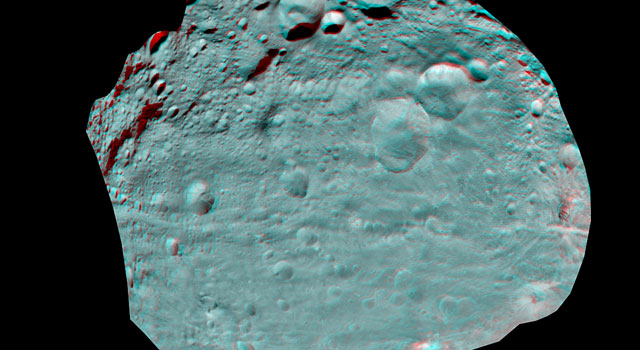Getting to Know the Giant Asteroid
Thursday, September 1st, 2011
As NASA’s Dawn spacecraft investigates its first target, the giant asteroid Vesta, Marc Rayman, Dawn’s chief engineer, shares a monthly update on the mission’s progress.

This anaglyph image of Vesta’s equator was put together from two clear filter images, taken on July 24, 2011 by the framing camera instrument aboard NASA’s Dawn spacecraft. The anaglyph image shows hills, troughs, ridges and steep craters. Image credit: NASA/JPL-Caltech/UCLA/MPS/DLR/IDA
› Full image and caption | › Read related news release
Dear Magdawnificents,
Dawn has completed the first phase of its exploration of Vesta with tremendous success, and the peripatetic adventurer is now in powered flight again, on its way to a new location from which to scrutinize its subject. Meanwhile, scientists are deeply engaged in analyzing the magnificent views the stalwart surveyor has transmitted to Earth.
Most of August was devoted to survey orbit. At an altitude of about 2,700 kilometers (1,700 miles), the ship sailed slowly around the world beneath it, completing a loop every 69 hours. Vesta rotates faster, turning once on its axis each 5 hours, 20 minutes. As we saw in the previous log, the survey orbit phase of the mission consisted of seven revolutions around Vesta, providing ample opportunities to acquire the rich bounty of data that scientists yearned for.
As Dawn follows its course, it passes over the north pole, then heads south on the day side of Vesta. On each orbit, it trained its sensors on the illuminated surface and filled its memory with the spectacular sights. On the other half of its orbit, gliding high above the dark landscape, it radioed its findings to distant Earth.
As we discussed last year, Vesta has seasons, just as your planet probably does. For readers on Earth, for example, it is summer in the northern hemisphere, and a region around the south pole is in constant darkness. On Vesta right now, the southern hemisphere is facing the sun, so everywhere between about 52 degrees north latitude and the north pole is in a long night. That ten percent of the surface is presently impossible to see. Because Dawn will stay in orbit around Vesta as together they travel around the sun, in 2012 it will be able to see some of this hidden scenery as the seasons advance.
The campaign of acquiring data in survey orbit was very complex. On the second, fourth, fifth, and sixth loops, the strategy included collecting more than Dawn’s memory could accommodate in the half of an orbit in which it was over sunlit terrain. Therefore, during those orbits, mission planners incorporated instructions to turn away from looking at Vesta to allow the spacecraft to point its main antenna to Earth for five to six hours. That provided time to transmit enough of its precious findings to make room for still more during the rest of the passage over the day side.
On the first and third revolutions, the computer in the visible and infrared mapping spectrometer (VIR) encountered an unexpected condition, so it stopped collecting data. When the spacecraft was next on the night side, controllers reconfigured the instrument so it could resume normal operation for the subsequent lap. Engineers and scientists from Italy who developed the complex device and from JPL are working closely together to establish the underlying cause. They have taken advantage of the extended periods in each orbit when the main antenna is pointing to Earth to run diagnostic tests on the unit. All indications are that it is healthy, and evidence points strongly to the glitches being related to some detail of the mode in which VIR collects and processes data. The team is confident that once they understand the behavior, they will be able to formulate plans to operate the spectrometer in ways that avoid triggering it.
Thanks to the strategy to perform more observations than needed, even with the interruptions, VIR accumulated a fantastic wealth of information. The principal scientific objective of survey orbit was to collect 5,000 sets of spectra or “frames.” A spectrum is the intensity of light at different wavelengths, and each frame consists of visible and infrared spectra at 256 locations on Vesta’s complex and mysterious surface. By the end of survey orbit, Dawn had obtained well in excess of 13,000 frames, or more than three million spectra. Acquiring more than one spectrum of the same location is valuable, as different angles of incident or reflected sunlight allow scientists to gain greater insight into the mineralogical composition and properties of the material. With an initial plan of observing 52 percent of the surface with VIR from survey orbit, the team is elated now to have spectra from about 63 percent.
The science camera has similarly overachieved. The intent was to photograph 60 percent of Vesta, but the entire 90 percent not in the darkness of northern winter has been captured at least five times. With pictures taken from multiple angles, stereo views can be constructed; and images at different times allow features to be observed under varied lighting conditions. All of the camera’s color filters were used, providing coverage in the near infrared and visible. Until recently, Vesta was known as little more than a smudge of light, but now scientists have more than 2,800 photos from Dawn’s survey.
A selection of stunning scenes of the latest world to come into the realm of humankind’s knowledge is here. As scientists pore through the treasure trove, they will continue to add their favorite views to that site.
This mission has already revealed far more about Vesta than a flyby mission could. While much more data will be obtained during the rest of Dawn’s residence there, the six gigabytes from VIR and the three gigabytes from the camera so far are enough to keep researchers busy (and extremely happy!) for a very long time as they tease out the nature of this alien world.






















